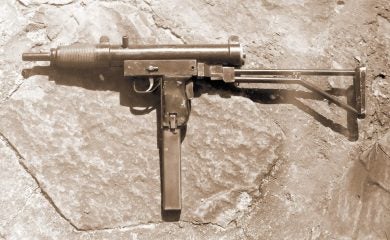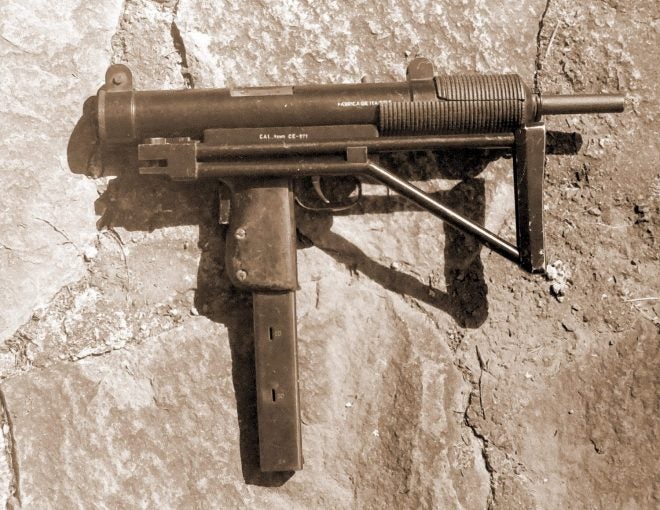This fourth assessment of the first 9x19mm submachine guns to come out of Brazilian Army’s — and IMBEL’s, after 1975– Fábrica de Itajubá (Itajubá Factory) will be somewhat of a flashback to the early 1970s. I have skipped the actual timeline back because the weapons involved here were quite different from the previously-described models of the mid-to-late seventies. It just so happened that in 1971 the guys at the facility’s Oficina de Protótipos (Prototypes Workshop) appeared to have given a better look at Israel’s Uzi buzzgun and decided to come out with a weapon with the same magazine-in-central-pistol-grip configuration.
The first prototype was designated FI Modelo 1971 (aka CE-971), an entirely conventional blowback-operated SMG that fired from the open bolt position and featured a cylindrical receiver and an involving bolt with a fixed striker. The fixed (reciprocating) cocking piece was a small cylindrical job that projected upward at about 45 degrees to the left, while the ejection window was to the right at about the same angle.

The sole CE-971 test specimen to come out of the Itajubá Factory Prototypes Workshop displays its Uzi-type configuration, although featuring different receiver and foldable stock.
A small rectangular lower receiver housed the firing mechanism and possessed a lookalike Uzi selector switch with the settings “S”, “R”, and “A” in a back-to-front sequence on the left side, while the magazine catch on the lower pistol grip was no less inspired. Yes, a safety lever was also present at the rear of the pistol grip… “Shalom!” The forward end of the gun received a wooden handguard of cylindrical shape, a foldable tubular stock allowing the reduction of the overall length from 690 to 430mm (the barrel was 250mm long). Weight? About 3.5kg.

Right side view of the same gun. Markings of the firing mechanism housing read “CAL. 9mm CE-971 – PROT. 1”, with “FÁBRICA DE ITAJUBÁ” on the tubular receiver, below the front sight.

With the stock folded, it was pretty compact at only 430mm in length (somewhat shorter than the Uzi). Markings on the receiver, below the cocking handle, read a hopeful “EXÉRCITO BRASILEIRO” (Brazilian Army).
The single CE-971 was followed by a subsequent CE-971A1 (aka CE-71A1), this having “Safe” and “Automatic” settings, only, for the switch-type fire selector placed on the left side, above the trigger. It had the same 250mm barrel, the reported cyclic rate of fire being in the region of 900 rounds per minute. Another distinguishing characteristic was the slightly conical profile of the handguard.

The CE-971A1 could be identified by the conical handguard and the two-position fire selector (here in “A”, forward). It was slightly shorter and lighter than the previous prototype.

The sole CE-971A1 prototype with the tubular stock folded. Its aperture rear sight was fixed to 200 meters.
Higher-res pics here: https://imgur.com/a/w8VwZ
 Your Privacy Choices
Your Privacy Choices
